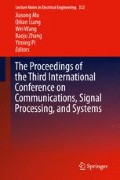Abstract
As the importance of analyzing system resource constrains on SAR automatically target recognition (ATR) has been noticed, more researchers start contributing to this field. In this paper, we focus on discussing the relationship between the performance of target detection and the resolution of SAR image which is regarded as one of the most important parameters of SAR imaging system. It is assumed that the resolution does not need to be good enough in target detection, but the modest reduction of resolution will provide a better trade-off between accuracy and speed. Firstly, an empirical operation is used to modify the resolution of raw images. Actually, the images with different resolutions should be derived by SAR imaging independently, but that’s not the point in this paper. Then the comparison using two methods is described, the optimal detector based on Bayesian expression and the sub-optimal detector, which is known as CFAR detection. The simulated data is used to evaluate the performance of detection, and the correctness of our suspicion is demonstrated in the experiment.
Access this chapter
Tax calculation will be finalised at checkout
Purchases are for personal use only
References
Conte E, De Maio A, Galdi C (2004) Statistical analysis of real clutter at different range resolutions. IEEE Trans Aerosp Electron Syst 40(3):903–918. doi:10.1109/TAES.2004.1337463
Novak LM, Halversen SD, Owirka GJ, Hiett M (1995) Effects of polarization and resolution on the performance of a SAR automatic target recognition system. Lincoln Lab J 8(1):49–68
Novak LM, Owirka GJ, Netishen CM (1993) Performance of a high-resolution polarimetric SAR automatic target recognition system. Lincoln Lab J 6(1)
DeVore M, Chamberlain R et al (2002) Tradeoffs between quality of results and resource consumption in a recognition system. In: Proceedings of IEEE international conference on IEEE application-specific systems, architectures and processors, pp 391–402. doi:10.1109/ASAP.2002.1030738
Devore MD (2001) Recognition performance from synthetic aperture radar imagery subject to system resource constraints. Dissertation, Washington University
Huddleston SH, Zhou X et al (2007) Statistical models for target detection in infrared imagery. Proc SPIE Autom Target Recognit 17:65661A. doi:10.1117/12.747148
Terzuoli A, McGowan J, et al. (2010) The effect of synthetic aperture radar image resolution on target discrimination. In: 38th COSPAR scientific assembly, vol 38. p 391
Dumitru CO, Datcu M (2013) Information content of very high resolution SAR images: study of feature extraction and imaging parameters. IEEE Trans Geosci Remote Sens 51(8):4591–4610
Schonhoff TA, Giordano AA (2006) Detection and estimation theory and its applications. Pearson College Division, America
El-Darymli K, McGuire P, Power D, Moloney C (2013) Target detection in synthetic aperture radar imagery: a state-of-the-art survey. J Appl Remote Sens 7(1):071598–071598. doi:10.1117/1.JRS.7.071598
Gao G (2010) Statistical modeling of SAR images: a survey. Sensors 10:775–795. doi:10.3390/s100100775
López-Martínez C, Fabregas X (2003) Polarimetric SAR speckle noise model. IEEE Trans Geosci Remote Sens 41(10):2232–2242. doi:10.1109/TGRS.2003.815240
O’Sullivan JA, DeVore MD et al (2001) SAR ATR performance using a conditionally Gaussian model. IEEE Trans Aerosp Electron Syst 37(1):91–108. doi:10.1109/7.913670
Shui PL, Xu SW, Liu HW (2011) Range-spread target detection using consecutive HRRPs. IEEE Trans Aerosp Electron Syst 47(1):647–665. doi:10.1109/TAES.2011.5705697
Bandiera F, Besson O, Ricci G (2011) Adaptive detection of distributed targets in compound-Gaussian noise without secondary data: a Bayesian approach. IEEE Trans Signal Process 59(12):5698–5708. doi:10.1109/TSP.2011.2167613
Acknowledgments
This work is supported in part by the National Natural Science Foundation of China under Grants 61271287, 61371048, 61301265.
Author information
Authors and Affiliations
Corresponding author
Editor information
Editors and Affiliations
Rights and permissions
Copyright information
© 2015 Springer International Publishing Switzerland
About this paper
Cite this paper
Yang, H., Cao, Z. (2015). Target Detection Performance Analysis of SAR Image with Different Resolutions Based on Template Matching. In: Mu, J., Liang, Q., Wang, W., Zhang, B., Pi, Y. (eds) The Proceedings of the Third International Conference on Communications, Signal Processing, and Systems. Lecture Notes in Electrical Engineering, vol 322. Springer, Cham. https://doi.org/10.1007/978-3-319-08991-1_19
Download citation
DOI: https://doi.org/10.1007/978-3-319-08991-1_19
Publisher Name: Springer, Cham
Print ISBN: 978-3-319-08990-4
Online ISBN: 978-3-319-08991-1
eBook Packages: EngineeringEngineering (R0)

